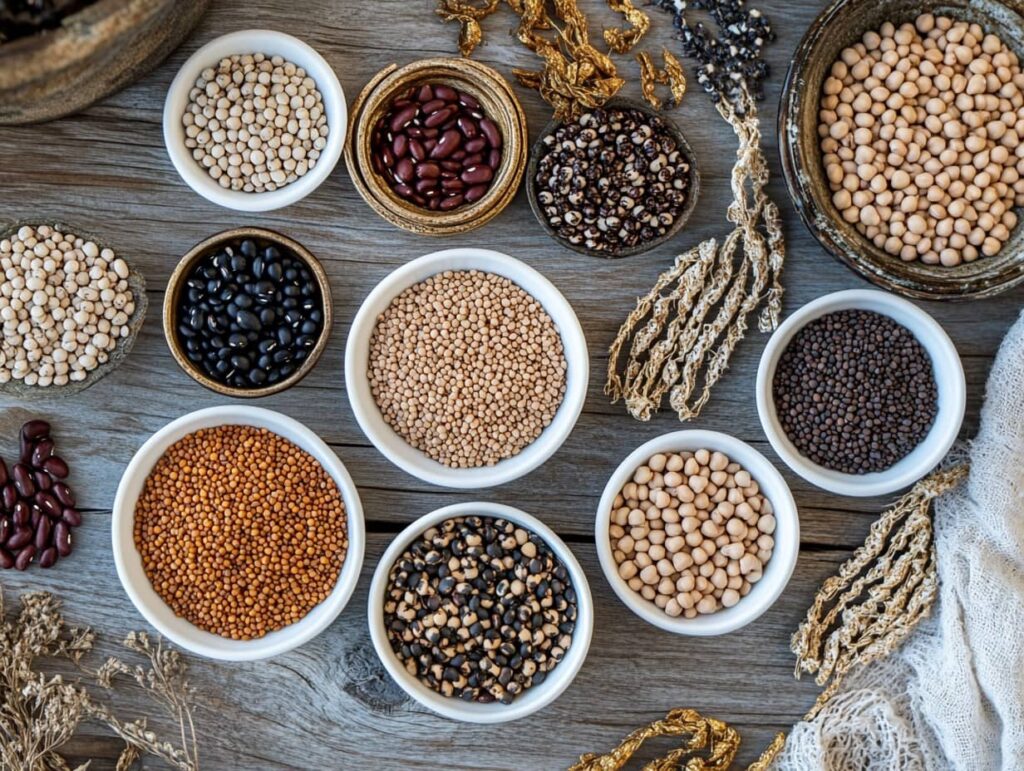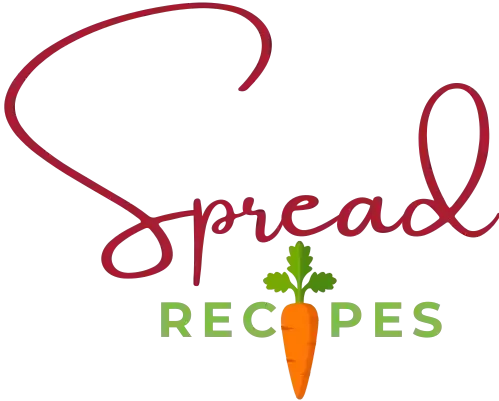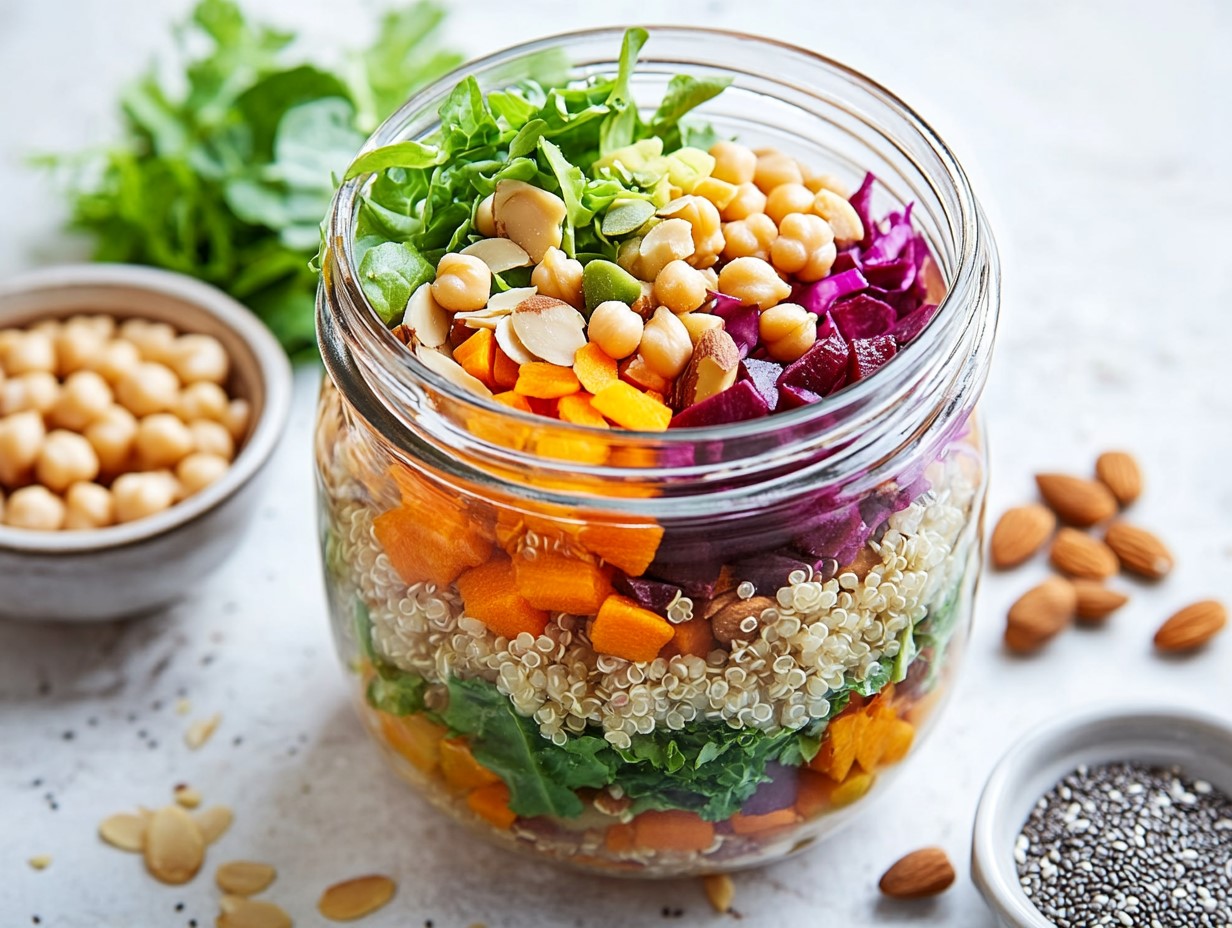Transitioning to or maintaining a vegan lifestyle is an exciting journey. One of the first questions people ask is, “What are the staple foods for a vegan diet?” In this guide, we’ll break it all down so you know exactly what to stock up on, how to use these foods, and why they’re essential. Whether you’re new to veganism or just looking to refine your pantry, this article has you covered!
Table of Contents
Understanding the Basics of Veganism
What Does It Mean to Eat Vegan?
At its core, veganism is about avoiding animal products. That means no meat, dairy, eggs, or any other animal-derived ingredients. Instead, vegans focus on plant-based foods. Sounds simple, right? But there’s more to it than just swapping out a burger for a salad.
Vegan diets emphasize whole, nutrient-rich foods that nourish the body and promote sustainability. The goal is to prioritize health while reducing harm to animals and the environment. Think grains, legumes, nuts, seeds, fruits, and veggies all the delicious basics! 😋
“Veganism isn’t just a diet; it’s a lifestyle centered on compassion, health, and environmental responsibility.”
Why Staple Foods Are Crucial in a Vegan Diet
Staple foods are the building blocks of any diet. For vegans, they provide the foundation for balanced meals, ensuring you get all the nutrients you need without relying on animal products. Staples like rice, beans, and leafy greens pack a punch when it comes to vitamins, minerals, and energy.
Without these basics, you’d spend way too much time (and money) scrambling to find suitable options. Having the right staples on hand simplifies meal prep and guarantees you’ll always have something tasty to eat.
The Essential Categories of Staple Vegan Foods
Grains: The Foundation of Vegan Meals
Grains are a vegan’s best friend. They’re versatile, filling, and budget-friendly. Plus, they’re rich in carbohydrates the body’s primary energy source. But not all grains are created equal. Let’s explore your options:
Popular Whole Grains for Vegan Diets
- Brown Rice: A hearty base for stir-fries and bowls. Packed with fiber.
- Quinoa: A complete protein (yes, all nine essential amino acids!) and perfect for salads.
- Oats: Breakfast staple, hello overnight oats! 🥣
- Barley: Great for soups and stews.
Gluten-Free Grain Alternatives
For those avoiding gluten, don’t worry you’ve got options!
- Millet: Mild flavor and works well in porridge.
- Buckwheat: Ideal for pancakes or soba noodles.
- Amaranth: Tiny, nutrient-dense, and slightly nutty.
Need ideas for quick meals? Our Vegan Appetizers Recipes and Tips offers simple, delightful dishes you can prepare in minutes.
Here’s a quick table for nutritional comparison:
| Grain | Calories (per 100g) | Protein | Fiber | Key Nutrients |
|---|---|---|---|---|
| Brown Rice | 111 | 2.6g | 1.8g | Manganese, Selenium |
| Quinoa | 120 | 4.1g | 2.8g | Iron, Magnesium |
| Millet | 119 | 3.5g | 1.3g | Phosphorus, Zinc |
Legumes: Protein-Packed Essentials
If grains are the foundation, legumes are the powerhouse. These little guys are your main source of plant-based protein and fiber. Whether it’s beans, lentils, or chickpeas, legumes can do it all.

Types of Beans and Their Uses
- Black Beans: Perfect for burritos and tacos.
- Kidney Beans: Great in chili or curry.
- Soybeans: Think tofu, tempeh, and edamame so versatile!
Lentils: A Nutritional Powerhouse
Lentils deserve their moment in the spotlight for being nutritious, versatile, and easy to cook. Available in green, red, yellow, and brown varieties, they adapt beautifully to soups, salads, curries, and even veggie burgers. Green lentils hold their shape, making them ideal for hearty salads, while red lentils cook quickly and blend into creamy dishes like dal or soups.
Nutritionally, lentils pack 18 grams of protein per cup, along with fiber, iron, and folate, making them a budget-friendly and health-packed option for plant-based diets. Best of all, they cook in under 30 minutes—no soaking required!
Chickpeas: From Hummus to Curry
Chickpeas are the ultimate multitaskers of the vegan world. Whether blended into hummus, roasted for a crispy snack, or simmered in a rich curry, they add flavor and texture to any dish. These protein-rich legumes boast 15 grams of protein per cup and are also loaded with fiber, calcium, and iron, supporting overall health.
From creamy dips to hearty stews, chickpeas shine in cuisines around the globe. Their versatility and nutritional profile make them a must-have staple for any vegan pantry! 💪
Nuts and Seeds: Healthy Fats and Nutrients
Nuts and seeds are tiny but mighty. They provide essential fatty acids, protein, and vitamins.
Commonly Used Nuts in Vegan Cooking
- Almonds: Perfect for snacking or almond milk.
- Cashews: The base for creamy sauces.
- Walnuts: A brain-boosting addition to salads.
Seeds as Superfoods: Chia, Flax, and More
Seeds are the unsung heroes of vegan diets. Sprinkle them on oatmeal, blend them into smoothies, or bake them into bread.
- Chia Seeds: High in omega-3s, they gel up for puddings.
- Flaxseeds: Ideal egg replacer in baking.
- Sunflower Seeds: A crunchy, nutritious snack.
Vegetables: The Heart of Vegan Cuisine
You can’t talk about vegan staples without mentioning vegetables. They’re colorful, nutrient-dense, and the star of many dishes.
Leafy Greens and Their Benefits
Leafy greens like spinach, kale, and Swiss chard are rich in iron, calcium, and vitamins A and C. They’re perfect in smoothies, salads, or sautéed as a side.
Root Vegetables: Filling and Nutritious Staples
Root veggies like potatoes, carrots, and beets are hearty and versatile. Mash them, roast them, or toss them in soups the possibilities are endless!
Affordable and Accessible Vegan Staples
Budget-Friendly Vegan Foods to Stock Up On
Contrary to popular belief, vegan staples aren’t expensive. In fact, foods like rice, beans, and frozen vegetables are some of the most affordable items in any grocery store. Stick to whole, unprocessed options to save money.
Where to Buy Vegan Staples Online and Locally
Need help finding vegan staples? Try local farmers’ markets for fresh produce or bulk stores for grains and legumes. Online retailers like Thrive Market and Amazon also offer excellent vegan-friendly options.
Common Problems in Transitioning to Vegan Foods
Switching to a vegan diet can feel like stepping into a whole new world. But don’t worry it’s totally doable with a little guidance! Let’s tackle the most common challenges and provide practical solutions. Explore How to Make Vegan Food Filling to learn how to make hearty meals that keep you energized throughout the day.
Difficulty Finding Staple Vegan Foods
It can be tricky to find vegan staples, especially if you live in a small town or rural area. Sometimes, even big grocery stores have limited options.
Solutions for Finding Vegan Staples in Small Towns
- Shop Smart: Look for ethnic markets they often have beans, lentils, and spices at great prices.
- Go Online: Websites like Thrive Market or iHerb specialize in vegan-friendly products. You can even buy in bulk to save money.
- DIY It: Can’t find plant-based milk or hummus? Make your own! Almond milk takes minutes, and chickpea hummus is foolproof.
“A little creativity goes a long way when you’re hunting for vegan ingredients!”
Balancing Nutritional Needs on a Vegan Diet
One of the biggest myths about veganism is that it’s hard to get all the nutrients you need. While some nutrients require extra attention, it’s completely manageable.
Common Nutritional Deficiencies and How to Avoid Them
- Protein: Focus on legumes, tofu, tempeh, and quinoa. Mixing grains with beans boosts the amino acid profile.
- Vitamin B12: This vitamin isn’t naturally found in plants. Opt for fortified foods (like plant-based milk) or take a supplement.
- Iron: Found in lentils, chickpeas, spinach, and pumpkin seeds. Pair with vitamin C (think oranges or tomatoes) to boost absorption.
- Omega-3 Fatty Acids: Chia seeds, flaxseeds, and walnuts are rich in alpha-linolenic acid (ALA), an essential omega-3.
Here’s a table to help you out:
| Nutrient | Vegan Sources | Daily Requirement |
|---|---|---|
| Protein | Lentils, Tofu, Quinoa | 50-60g |
| Vitamin B12 | Fortified cereals, Supplements | 2.4mcg |
| Iron | Spinach, Pumpkin Seeds | 8-18mg |
| Omega-3 Fatty Acids | Chia, Flax, Walnuts | 1.1-1.6g |
Preparing Vegan Staples for Everyday Meals
Let’s be honest: cooking vegan staples might seem like a chore at first. But with a bit of prep work, your weeknight dinners can become effortless and delicious.
Batch Cooking Vegan Staples
Ever heard of “batch cooking”? It’s a lifesaver for busy folks! Dedicate one day to cooking large portions of grains, legumes, and roasted veggies, then store them in the fridge or freezer.
What to Batch Cook:
- Quinoa or Brown Rice: Cooks in under 20 minutes and stores for up to five days. Perfect for grain bowls!
- Lentils or Chickpeas: Boil them in bulk and freeze in portions for soups or salads.
- Roasted Veggies: Sweet potatoes, zucchini, and carrots are perfect for reheating.
“Meal prepping is like giving your future self a big high-five. You’ll thank yourself later!” 👏
Quick and Easy Recipes Using Staple Vegan Foods
Snacking while vegan is easier than you think. Whether you’re meal prepping or need something on the go, our Vegan Snack Guide is packed with innovative snack ideas for any occasion.
5-Minute Chickpea Salad
- Ingredients: 1 can of chickpeas, 1 avocado, cherry tomatoes, lemon juice, salt, and pepper.
- Directions: Toss everything together, and boom you’ve got a creamy, protein-packed salad! 🥗
Easy Vegan Stir-Fry
- Ingredients: Cooked rice, frozen veggies, soy sauce, tofu, and sesame oil.
- Directions: Stir-fry everything in a pan. Add soy sauce to taste. Dinner = done.
Chia Pudding
- Ingredients: 3 tbsp chia seeds, 1 cup almond milk, 1 tsp maple syrup, fruit for topping.
- Directions: Mix, chill overnight, and top with fresh fruit. Dessert for breakfast? Yes, please. 🍓
Innovative Ways to Use Vegan Staples
Sometimes, the best meals come from getting creative with your staples. Let’s think outside the box!
Creative Recipes to Try with Grains and Legumes
- Grain Bowls: Layer brown rice or quinoa with roasted veggies, beans, and a drizzle of tahini. It’s like art you can eat.
- Lentil “Meatballs”: Blend lentils, breadcrumbs, and spices to form delicious, protein-packed meatball alternatives.
Transforming Nuts and Seeds into Delicious Dishes
- Cashew Cheese: Blend soaked cashews with nutritional yeast, garlic, and lemon juice for a creamy cheese substitute.
- Sunflower Seed Pesto: Swap pine nuts for sunflower seeds in your favorite pesto recipe. It’s cheaper and just as tasty!
Benefits of Including Staple Vegan Foods in Your Diet
Health Benefits of a Whole-Food Vegan Diet
Staple vegan foods aren’t just tasty they’re incredibly good for you. Studies show that plant-based diets can lower the risk of heart disease, reduce inflammation, and even help manage weight.
Quick Stats:
- Vegans tend to have 75% lower rates of high blood pressure. 💓
- Plant-based diets are linked to a 32% lower risk of type 2 diabetes.
Environmental Impact of Vegan Staples
Did you know that grains, legumes, and veggies have a much smaller carbon footprint than meat and dairy? By choosing these staples, you’re doing your part to combat climate change. 🌍
Frequently Asked Questions About Staple Vegan Foods
Can Vegan Staples Provide Enough Protein?
Absolutely! Foods like lentils, quinoa, tofu, and nuts are all protein powerhouses. Combining grains with legumes ensures you get all the essential amino acids.
How Do I Store Vegan Staples Properly?
- Grains: Store in airtight containers in a cool, dry place.
- Legumes: Cooked legumes can be frozen in portions.
- Nuts and Seeds: Refrigerate or freeze to prevent oils from going rancid.
Are Vegan Staples Expensive?
Not at all! Staples like rice, beans, and oats are some of the cheapest foods around. Fancy vegan products can be pricey, but you don’t need them to thrive.
Conclusion: Embracing Staple Vegan Foods in Your Lifestyle
Stocking up on vegan staples is like building a treasure chest of endless culinary possibilities, filled with ingredients that not only nourish your body but also inspire creativity in the kitchen. With a little planning and a well-stocked pantry, you can whip up meals that are delicious, wholesome, and budget-friendly without ever feeling limited. Lentils, quinoa, and fresh veggies become your best allies in crafting everything from hearty stews to vibrant salads and protein-packed bowls. Embrace the simplicity and versatility of these essentials, and watch your vegan journey transform into an exciting and flavorful adventure! 🌱

